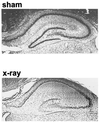Alleviation of x-irradiation-based deficit in memory-based learning by D-amphetamine: suggestions for attention deficit-hyperactivity disorder
- PMID: 9576962
- PMCID: PMC20457
- DOI: 10.1073/pnas.95.10.5785
Alleviation of x-irradiation-based deficit in memory-based learning by D-amphetamine: suggestions for attention deficit-hyperactivity disorder
Erratum in
- Proc Natl Acad Sci U S A 1998 Sep 15;95(19):11499
Abstract
Selective exposure to x-irradiation during infancy, from postnatal days (PND) 2-11 in the rat, results in severe hippocampal granule cell hypoplasia. Preweanling (PND 17-18) rats, which suffer such hippocampal granule-cell agenesis, show deficits in patterned single alternation (PSA), a form of memory-based learning. Deficits in short-term memory along with increased arousal have been suggested as characteristic of children diagnosed with attention deficit-hyperactivity disorder (ADHD). We report here on the ameliorating effects of D-amphetamine, a drug commonly used in the treatment of ADHD, before Ritalin, on PSA, after infantile (PND 2-15) exposure to x-irradiation. After i.p. injections of 0.3 mg/kg D-amphetamine, the onset and magnitude of the PSA memory-based discrimination in the x-irradiated preweanling rats was restored to about the level of controls. These results, showing alleviation of x-irradiation-related deficits in short-term memory by D-amphetamine injections, along with our earlier and present results, showing substantial deficits after x-irradiation alone, encourage the hypothesis that hippocampal granule-cell hypoplasia, which would occur in humans prenatally and is Altman's model of "minimal brain dysfunction" [Altman, J. (1986) in Learning Disabilities and Prenatal Risk, ed. Lewis, M. (Univ. of Illinois Press, Urbana), pp. 241-304], may be a factor in at least some forms of ADHD and may provide a basis for an animal model of the disease.
Figures


References
-
- Altman J. In: Learning Disabilities and Prenatal Risk. Lewis M, editor. Urbana: Univ. of Illinois Press; 1986. pp. 241–304.
-
- Amsel A. Cognit Emotion. 1990;4:239–268.
-
- Douglas V I, Parry P A. J Abnorm Child Psychol. 1983;11:313–326. - PubMed
-
- Amsel A. Frustration Theory: An Analysis of Dispositional Learning and Memory. Cambridge, U.K.: Cambridge Univ. Press; 1992.
-
- Bayer S A, Brunner R L, Hine R, Altman J. Nature (London) 1973;242:222–224. - PubMed
MeSH terms
Substances
LinkOut - more resources
Full Text Sources
Medical
Research Materials
Miscellaneous

